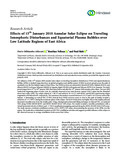Effects of 15th January 2010 Annular Solar Eclipse on Traveling Ionospheric Disturbances and Equatorial Plasma Bubbles over Low Latitude Regions of East Africa

View/
Date
2022-11-21Author
Athwart, Davis Odhiambo
Ndinya, Boniface
Baki, Paul
Metadata
Show full item recordAbstract
The influence of the 15th January 2010 annular solar eclipse on traveling ionospheric disturbances (TIDs) and equatorial plasma bubbles (EPBs) is studied using data from six global navigation and satellite system (GNSS) receivers spread across the path of annularity over the low latitude region of East Africa. The GNSS receivers are stationed at Nairobi (RCMN), Malindi (MAL2), and Eldoret (MOIU) in Kenya; Mbarara (MBAR) in Uganda; Kigali (NURK) in Rwanda; and Mtwara (MTWA) in Tanzania. The study period ranges from 12th to 18th January 2010, three days before and after the 15th January 2010 annular solar eclipse. The year 2010 marked the beginning phase of solar cycle 24, evidently observed in low total electron content (TEC) values and the disturbed storm time index (Dst). The eclipse started at 7 : 06 LT and ended at 10 : 14 LT, with MOIU and RCMN experiencing eclipse magnitudes of 0.946 and 0.93, respectively. The maximum obscuration occurred between 8 : 21 LT and 8 : 34 LT across most of the stations. A detrending on vertical TEC (VTEC) derived from GNSS receivers across or close to the path of totality revealed a reduction of ∼2-3 TECU during the maximum phase of the eclipse. The level of reduction was highly close to the totality path and decreased smoothly away from the totality path. Using a background polynomial fitting technique on diurnal TEC, we analyzed TIDs along NURK-MBAR-MOIU and MOIU-RCMN-MAL2 GPS arrays. The results revealed a wavelike perturbation with a virtual horizontal velocity of 830m/s and ∼1 TECU amplitude propagating eastward along the MOIU-RCMN-MAL2 GPS array. The study reports a moderate scintillation activity of 0.5 ≤ ROTI ≤ 0.9 values, demonstrating the presence of few EPBs over the region. The results show a latitudinal variation in GPS-TEC scintillation activities and suggest a possible influence of the eclipse on the observed increase in average scintillation levels across East Africa.
URI
https://doi.org/10.1155/2022/5263997https://downloads.hindawi.com/journals/aa/2022/5263997.pdf?_ga=2.82541205.2099571617.1688125324-1417752248.1684503676
http://ir-library.mmust.ac.ke:8080/xmlui/handle/123456789/2243
Collections
- Gold Collection [1026]
